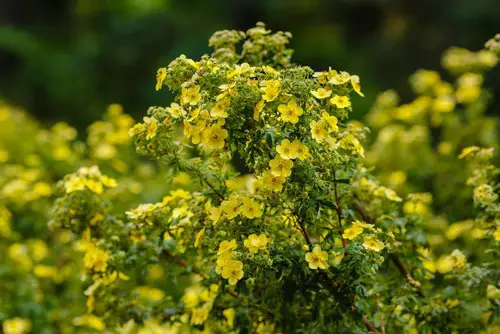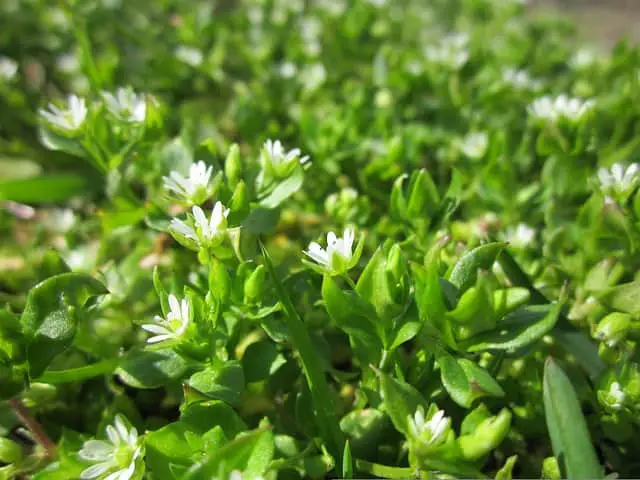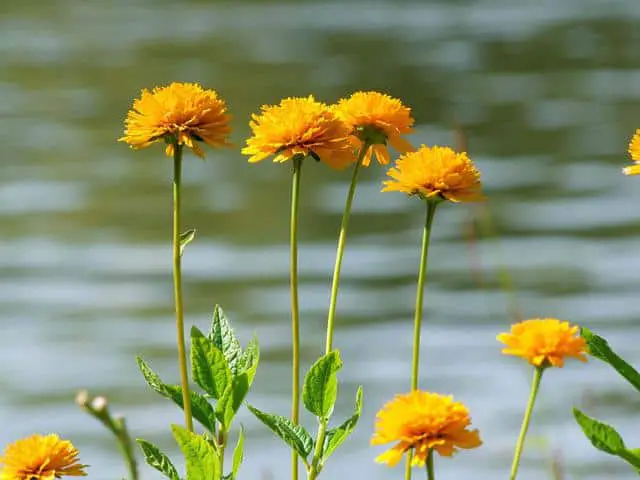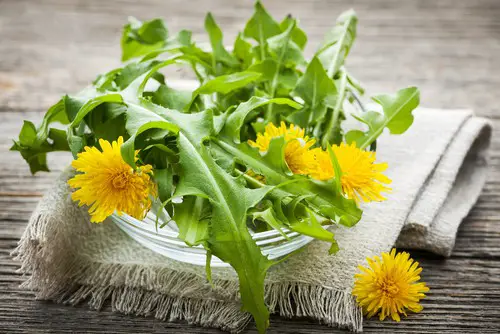The dandelion, or Taraxacum officinale, was probably one of the first plants that many of us learnt to recognize. Dandelions are a well-known weed that seems to pop up everywhere in the spring and summer. But did you know that there are actually a number of plants that have leaves that look very similar to dandelion leaves?
- Cinquefoil
- Cat’s Ear
- Common Chickweed
- Creeping Charlie
- Clover
- False Dandelion
- Field Bindweed
- French Mullein
- Henbit
- Marsh Marigold
As you can see, there are a number of plants with leaves that look like dandelion leaves. However, there are also some key differences that can help you distinguish between these plants.
So next time you’re out in your garden or lawn, take a closer look at the plants around you and see if you can spot any of these resemblances!
Plants That Look Like Dandelion Leaves
See other similar posts:
1. Cinquefoil

The cinquefoil plant is a member of the rose family and is related to the strawberry. It is a perennial herb that typically grows to between six and 18 inches in height. The leaves of the cinquefoil are green and are divided into five leaflets. The flowers of the cinquefoil are small and yellow, and they bloom in clusters.
The cinquefoil is native to Europe, Asia, and North America. In some parts of the world, it is considered to be a weed, as it can spread rapidly and crowd out other plants. However, the cinquefoil is also used as an herbal remedy for a variety of ailments, including diarrhea, wounds, and stomach cramps.
2. Cat’s Ear
The plant known as cat’s ear (Hypochaeris radicata) gets its name from the shape of its leaves, which bear a resemblance to the ears of a cat. This plant is a member of the daisy family and is native to Europe and Asia. It has since been introduced to many other parts of the world, where it often grows as a weed.
Cat’s ear is a low-growing plant with yellow flowers that bloom from spring to fall. The plant has a deep taproot and can reproduce both vegetatively and via seed.
The seeds are contained in white, fluffy heads that are dispersed by the wind. Cat’s ear is often considered a nuisance weed due to its ability to spread rapidly and crowd out other plants.
3. Common Chickweed

Chickweed (Stellaria media) is a small, delicate annual plant that is often found in lawns, gardens, and other areas of disturbed soil. It has narrow, lance-shaped leaves that are similar in appearance to dandelion leaves, and its small white flowers have five petals arranged in the shape of a star.
Chickweed is a low-growing plant that typically only reaches a height of 8-10 inches. However, its creeping stems can spread outwards to form a dense mat of vegetation. Chickweed is a relatively easy plant to control, as it is not tolerant of shade or competition from other plants.
4. Creeping Charlie
Creeping Charlie is a common weed that can be found in many lawns. It is often mistaken for dandelion leaves because of its similar shape and size. However, there are a few key differences between these two plants. Creeping Charlie has hairy leaves, while dandelion leaves are smooth.
Additionally, the leaves of Creeping Charlie are typically more green than the yellowish color of dandelion leaves. Finally, dandelions have a deep taproot, while Creeping Charlie has shallow, creeping roots that spread outwards from the plant.
Although Creeping Charlie is technically a weed, many people enjoy its cheerful appearance and allow it to remain in their lawns.
5. Clover
Clover is a member of the legume family, which means that it has the ability to fix nitrogen in the soil. This makes it an important plant for agriculture as it helps to improve soil fertility. Clover is also often used as a cover crop or forage crop. It is palatable for livestock and can provide them with essential nutrients.
Clovers look similar to dandelion leaves, but the two plants are not related. Dandelion leaves are more elongated and have sharply-toothed edges, while clover leaves are more rounded with smooth edges. Additionally, dandelion leaves are darker green in color than clover leaves.
6. False Dandelion
The False Dandelion (Pyrrhopappus pauciflorus) is a plant that resembles the common dandelion (Taraxacum officinale). However, there are several key differences between these two plants. false Dandelions have only one flower head per plant, while dandelions have multiple heads.
Additionally, false Dandelions have hairless leaves, while dandelion leaves are hairy. Finally, false Dandelions typically grow in open areas such as meadows or fields, while dandelions can be found in a variety of habitats.
Despite these differences, false Dandelions are often confused with dandelions due to their similar appearance.
7. Field Bindweed
The plant known as field bindweed (Convolvulus arvensis) is a member of the morning glory family. It is a vigorous, climbing or trailing vine that can reach up to 6 feet in length. The leaves are arrowhead-shaped and have a light green to white color. The flowers are white or pink, and they bloom from June to September.
Field bindweed is native to Europe and Asia, but it has been introduced to North America, where it is considered to be a weed. The plant prefers open fields and disturbed areas, such as roadsides and construction sites. It is difficult to control because it spreads rapidly by seed and root.
8. French Mullein
French Mullein (Verbascum Thapsus) is a tall, flowering plant that is native to Europe and Asia. It has long, thin leaves that are similar in appearance to dandelion leaves. The plant’s flowers are yellow and are clustered together in a dense spike. French Mullein grows best in full sun and well-drained soil.
It is a hardy plant that is tolerant of drought and poor soil conditions. French Mullein is often used as an ornamental plant in gardens. It is also sometimes used as a natural pesticide, as it contains compounds that can kill many types of insects. French Mullein typically blooms from June to August.
9. Henbit
The Henbit plant is a common flower that blooms in the spring. It’s a member of the mint family and its leaves look very similar to dandelion leaves. The plant is native to Europe, Asia, and Africa, but it now grows all over the world. Henbit flowers are purple and they grow in clusters.
The plant is low-growing and usually only reaches about 10 inches tall. The leaves of the Henbit plant are what sets it apart from other plants in the mint family.
They’re more rounded than other mint leaves and they have a toothed edge. The leaves are also a deep green color. When the plant blooms, the flowers attract bees and other pollinators.
10. Marsh Marigold

The Marsh Marigold is a flowering plant that is found in marshes and wet meadows across Europe and Asia. The plant gets its common name from its bright yellow flowers, which resemble those of the dandelion. Marsh marigolds typically grow to a height of one to two feet and have thick, glossy leaves.
The flowers of the marsh marigold are edible and are often used in salads or as a garnish. The plant is also known for its medicinal properties and has been used to treat various ailments such as colds, flu, and stomach problems.
Conclusion
When you see a plant with bright yellow flowers and deeply lobed leaves, you probably think of a dandelion. But did you know that there are actually a number of plants that have leaves that look very similar to dandelion leaves?
All of these plants are in the Asteraceae family, which is also known as the daisy family. This family includes over 16,000 different species, making it one of the largest families of flowering plants in the world.
So next time you see a plant with dandelion-like leaves, don’t immediately assume that it’s a weed. It might just be a member of the daisy family!
Frequently Asked Questions
Are there poisonous plants that look like dandelions?
Dandelions are also part of the Asteraceae family, which includes a number of other poisonous plants.
Chrysanthemums, for example, contain pyrethrins, which can cause vomiting and diarrhea if ingested in large quantities. Similarly, tansy ragwort contains pyrrolizidine alkaloids that can damage the liver. Thankfully, dandelions are not poisonous to humans; however, they can be harmful to pets if eaten in large quantities.
What is the difference between dandelion and false dandelion?
Dandelions and false dandelions are both members of the Taraxacum genus, but they are two different species. Dandelions are native to Europe and Asia, while false dandelions are native to North America.
Dandelions have long, lance-shaped leaves with serrated edges, while false dandelions have shorter, wider leaves with smooth edges.
The flower heads of dandelions are slightly smaller than those of false dandelions, and they have fewer rays (the petals that surround the center of the flower).

Hey, I’m Lisa and I’ve been an avid gardener for over 30 years. I love writing, talking and living in the garden! Feel free to connect with me on my socials below

